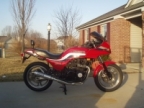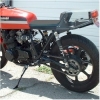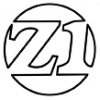Narrow / Wide Band Fuel Air
- 4TheKZ1000
-
Topic Author
- User
-

Public
- Thanks: 0
Narrow / Wide Band Fuel Air
10 Nov 2013 09:26
Haven't seen Narrow / Wide Band O2 Fuel Air topic come up.
Is anyone out there running a fuel/air gauge? or using it for tuning engine.
Some of my questions are:
1. Do you use a narrow or wide band?
2. What is the placement of exhaust bung and O2 sensor.
3. What type of controller is used to register/interoperate information?
4. What can one expect the cost to be for equipment only?
I'm sure some questions were missed.
Thanks
Is anyone out there running a fuel/air gauge? or using it for tuning engine.
Some of my questions are:
1. Do you use a narrow or wide band?
2. What is the placement of exhaust bung and O2 sensor.
3. What type of controller is used to register/interoperate information?
4. What can one expect the cost to be for equipment only?
I'm sure some questions were missed.
Thanks
Please Log in or Create an account to join the conversation.
- Nebr_Rex
-

- Offline
- User
-

Registered
- Posts: 1887
- Thanks: 295
Re: Narrow / Wide Band Fuel Air
10 Nov 2013 09:50
K&N narrow band, been on the bike since December 2002.
Jut as accurate as the local bike shops wide band in the narrow bands range.
Cost around $200 new.
Jut as accurate as the local bike shops wide band in the narrow bands range.
Cost around $200 new.
2002 ZRX1200R
81 GPz1100
79 KZ1000st daily ride
79 KZ1000mk2 prodject
78 KZ650sr
78 KZ650b
81 KZ750e
80 KZ750ltd
77 KZ400/440 cafe project
76 KZ400/440 Fuel Injected
www.dotheton.com/forum/index.php?topic=39120.0
.
81 GPz1100
79 KZ1000st daily ride
79 KZ1000mk2 prodject
78 KZ650sr
78 KZ650b
81 KZ750e
80 KZ750ltd
77 KZ400/440 cafe project
76 KZ400/440 Fuel Injected
www.dotheton.com/forum/index.php?topic=39120.0
.
Attachments:
Please Log in or Create an account to join the conversation.
- etbike3135
-
- Offline
- User
-

Registered
- Posts: 381
- Thanks: 50
Re: Narrow / Wide Band Fuel Air
10 Nov 2013 10:26
i use the wego. Best thing I ever bought for tuning carbs. What I thought I knew before, I didn't know. I welded the sensor right after the collector. Its neat to see the differences weather can play with tuning.
1973 Kawasaki Z1
18 years in dragbikes
18 years in dragbikes
Please Log in or Create an account to join the conversation.
- 4TheKZ1000
-
Topic Author
- User
-

Public
- Thanks: 0
Re: Narrow / Wide Band Fuel Air
10 Nov 2013 10:28
Where should a KZ 1000 be on the O2 number when running right? 13, 14, 15
Please Log in or Create an account to join the conversation.
- koolaid_kid
-

- Offline
- User
-

Registered
- Posts: 783
- Thanks: 99
Re: Narrow / Wide Band Fuel Air
10 Nov 2013 10:48
A narrow band O2 sensor is used to check the efficiency of a catalytic converter and to allow the engine computer to adjust the fuel trims on fuel injectors. It is almost impossible to tune an engine using a narrow band because it does not have enough range.
A wideband O2 sensor is used for tuning the AFR on any engine. I use an Innovate LM-1 wideband, since replaced by an LM-2.
The AFR on an air cooled engine such as the KZ1000 will vary, depending on what is being done. For example, during normal cruising, not under any load to speak of, it should be near Lambda, which is 14.7 AFR. You want an air cooled engine to run just a bit richer than Lambda, perhaps around 14.5 or so.
Under load, such as full throttle, you will want it to be much richer, at least 12.5, even approaching 11.5, since a richer mixture also serves to cool the combustion chamber. When under a load, but not WOT, it should be in between.
A wideband O2 sensor is used for tuning the AFR on any engine. I use an Innovate LM-1 wideband, since replaced by an LM-2.
The AFR on an air cooled engine such as the KZ1000 will vary, depending on what is being done. For example, during normal cruising, not under any load to speak of, it should be near Lambda, which is 14.7 AFR. You want an air cooled engine to run just a bit richer than Lambda, perhaps around 14.5 or so.
Under load, such as full throttle, you will want it to be much richer, at least 12.5, even approaching 11.5, since a richer mixture also serves to cool the combustion chamber. When under a load, but not WOT, it should be in between.
1983 GPz 750
810 Wiseco, Kerker, K&N, DynoJet S3, Accel, Progressive, etc.
810 Wiseco, Kerker, K&N, DynoJet S3, Accel, Progressive, etc.
Please Log in or Create an account to join the conversation.
- loudhvx
-

- Offline
- KZr Legend
-

Registered
- Posts: 10864
- Thanks: 1618
Re: Narrow / Wide Band Fuel Air
10 Nov 2013 14:43 - 10 Nov 2013 14:58koolaid_kid wrote: A narrow band O2 sensor is used to check the efficiency of a catalytic converter and to allow the engine computer to adjust the fuel trims on fuel injectors. It is almost impossible to tune an engine using a narrow band because it does not have enough range.
A wideband O2 sensor is used for tuning the AFR on any engine. I use an Innovate LM-1 wideband, since replaced by an LM-2.
The AFR on an air cooled engine such as the KZ1000 will vary, depending on what is being done. For example, during normal cruising, not under any load to speak of, it should be near Lambda, which is 14.7 AFR. You want an air cooled engine to run just a bit richer than Lambda, perhaps around 14.5 or so.
Under load, such as full throttle, you will want it to be much richer, at least 12.5, even approaching 11.5, since a richer mixture also serves to cool the combustion chamber. When under a load, but not WOT, it should be in between.
That's pretty much right on.
As you close the throttle, the AFR will go leaner, and as you open the throttle it will go richer.
There's a few threads that should come up in a "wideband" or "innovate" search, but the search is not working too well.
I had to go to a google search to find this thread:
kzrider.com/forum/3-carburetor/506548-wide-band-oxygen-sensor
Here's the one I started a while ago:
www.kzrider.com/forum/3-carburetor/30748...imitstart=0&start=20
There are quite a few other threads, but they are not showing up.
I know Testarossa had a thread going, and few other members too.
1981 KZ550 D1 gpz.
Kz550 valve train warning.
Other links.
Kz550 valve train warning.
Other links.
Last edit: 10 Nov 2013 14:58 by loudhvx.
The following user(s) said Thank You: 4TheKZ1000
Please Log in or Create an account to join the conversation.
- steell
-

- Offline
- User
-

Registered
- Posts: 6850
- Thanks: 208
Re: Narrow / Wide Band Fuel Air
10 Nov 2013 19:18koolaid_kid wrote: A narrow band O2 sensor is used to check the efficiency of a catalytic converter and to allow the engine computer to adjust the fuel trims on fuel injectors. It is almost impossible to tune an engine using a narrow band because it does not have enough range.
A wideband O2 sensor is used for tuning the AFR on any engine. I use an Innovate LM-1 wideband, since replaced by an LM-2.
The AFR on an air cooled engine such as the KZ1000 will vary, depending on what is being done. For example, during normal cruising, not under any load to speak of, it should be near Lambda, which is 14.7 AFR. You want an air cooled engine to run just a bit richer than Lambda, perhaps around 14.5 or so.
Under load, such as full throttle, you will want it to be much richer, at least 12.5, even approaching 11.5, since a richer mixture also serves to cool the combustion chamber. When under a load, but not WOT, it should be in between.
You're welcome!
KD9JUR
Please Log in or Create an account to join the conversation.
- koolaid_kid
-

- Offline
- User
-

Registered
- Posts: 783
- Thanks: 99
Re: Narrow / Wide Band Fuel Air
10 Nov 2013 19:52
Good links, loudhvx. I would like to add a few things that may not have been mentioned. I will use the Innovate brand since that is what I use, but there are other brands out there. Some good, some not so good. Generally, you get what you pay for.
First, they come in two flavors, portable, like the LM-1, and mounted, like the LC-1. My LM-1 has a logging feature built in, IIRC the LC-1 needs to have a computer connected to it to log data. On my LM-1, I can ride to the test area, start recording, do my runs, take it home, connect it to my PC, download and analyze the data. Works good for me. I also use it on cars to diagnose converter issues and fuel injector issues.
Second, since I use my LM-1 on both bikes and cars, I have an adapter which allows me to stick it up a car tailpipe or a bike collector if the cap comes off like my Kerker does. It takes up room. If you do not have the room, you will have to weld a bung into your exhaust. For a 4-1, you put it in the collector, after all the header pipes come together. If you remove the sensor, plug the hole with a stainless steel plug with a wrench connection, not an allen head connector, I am told a Toyota drain plug of the proper diameter will also work. Use lots of anti-seize so you can remove it the next time you want to run some tests.
Third, the sensor must always be powered, To run the engine with a non-powered sensor is to purchase a replacement sensor, because they will be destroyed. And they are expensive.
General notes:
I put the LM-1 data logger in my tank bag. I turn the bike ignition switch to ON and let the sensor come to operating temperature. I start the engine and verify that everything is working. The LM-1 has a display that shows the AFR (or Lamda if you are into self-inflicted pain) and wait until it stabilizes. I start the engine, let it warm up, then ride to the test area. I stage, turn on the record function, make my runs. I then stop and turn off the record function. I go home, connect the LM-1 to my PC (the sensor must also be connected, so I have a 110V AC to 12V DC transformer) and download the log data. I load the file into Excel, convert it into an Excel spreadsheet, go through the file until I find the areas of interest, and examine the data. It is quite accurate and makes tuning a cinch.
First, they come in two flavors, portable, like the LM-1, and mounted, like the LC-1. My LM-1 has a logging feature built in, IIRC the LC-1 needs to have a computer connected to it to log data. On my LM-1, I can ride to the test area, start recording, do my runs, take it home, connect it to my PC, download and analyze the data. Works good for me. I also use it on cars to diagnose converter issues and fuel injector issues.
Second, since I use my LM-1 on both bikes and cars, I have an adapter which allows me to stick it up a car tailpipe or a bike collector if the cap comes off like my Kerker does. It takes up room. If you do not have the room, you will have to weld a bung into your exhaust. For a 4-1, you put it in the collector, after all the header pipes come together. If you remove the sensor, plug the hole with a stainless steel plug with a wrench connection, not an allen head connector, I am told a Toyota drain plug of the proper diameter will also work. Use lots of anti-seize so you can remove it the next time you want to run some tests.
Third, the sensor must always be powered, To run the engine with a non-powered sensor is to purchase a replacement sensor, because they will be destroyed. And they are expensive.
General notes:
I put the LM-1 data logger in my tank bag. I turn the bike ignition switch to ON and let the sensor come to operating temperature. I start the engine and verify that everything is working. The LM-1 has a display that shows the AFR (or Lamda if you are into self-inflicted pain) and wait until it stabilizes. I start the engine, let it warm up, then ride to the test area. I stage, turn on the record function, make my runs. I then stop and turn off the record function. I go home, connect the LM-1 to my PC (the sensor must also be connected, so I have a 110V AC to 12V DC transformer) and download the log data. I load the file into Excel, convert it into an Excel spreadsheet, go through the file until I find the areas of interest, and examine the data. It is quite accurate and makes tuning a cinch.
1983 GPz 750
810 Wiseco, Kerker, K&N, DynoJet S3, Accel, Progressive, etc.
810 Wiseco, Kerker, K&N, DynoJet S3, Accel, Progressive, etc.
The following user(s) said Thank You: 4TheKZ1000
Please Log in or Create an account to join the conversation.
- 4TheKZ1000
-
Topic Author
- User
-

Public
- Thanks: 0
Re: Narrow / Wide Band Fuel Air
25 Nov 2013 19:08 - 25 Nov 2013 19:22
What do you guys think about these setups ?
www.dynotunenitrous.com/store/scripts/pr...ew.asp?idproduct=150
www.dynotunenitrous.com/store/scripts/pr...ew.asp?idproduct=391
www.dynotunenitrous.com/store/scripts/pr...ew.asp?idproduct=150
www.dynotunenitrous.com/store/scripts/pr...ew.asp?idproduct=391
Last edit: 25 Nov 2013 19:22 by 4TheKZ1000.
Please Log in or Create an account to join the conversation.
- Jeff.Saunders
-

- Offline
- Vendor
-

Vendors
- Posts: 1294
- Thanks: 183
Re: Narrow / Wide Band Fuel Air
26 Nov 2013 11:36
I added a cheap K&N setup to my turbo bike a couple of years ago. It helped resolve a lean spot in the mid range that wasn't easy to figure out by riding. I want to replace the current K&N setup with one of these combo units with data logging in the future.
www.aemelectronics.com/wideband-air-fuel-systems-15
www.aemelectronics.com/wideband-air-fuel-systems-15
www.z1enterprises.com
Z1 Ent on Facebook,
The following user(s) said Thank You: 4TheKZ1000
Please Log in or Create an account to join the conversation.
- Stazi
-
- Offline
- User
-

Registered
- Posts: 115
- Thanks: 11
Re: Narrow / Wide Band Fuel Air
26 Nov 2013 12:37
These guys have the best A/F setups out there:
www.innovatemotorsports.com/
www.innovatemotorsports.com/
82 KZ1000-K2 LTD
Please Log in or Create an account to join the conversation.
- 4TheKZ1000
-
Topic Author
- User
-

Public
- Thanks: 0
Re: Narrow / Wide Band Fuel Air
26 Nov 2013 12:49Stazi wrote: These guys have the best A/F setups out there:
www.innovatemotorsports.com/
Nice gauge, which package do you like ? Price is good.
Please Log in or Create an account to join the conversation.
Moderators: Street Fighter LTD
